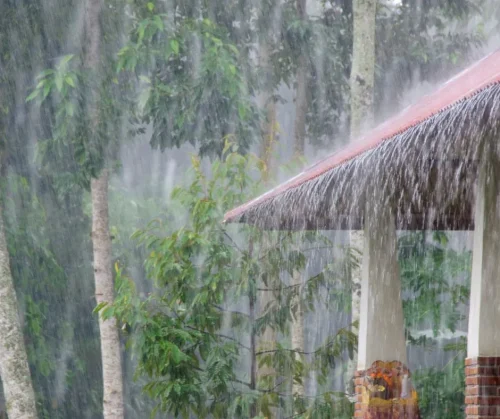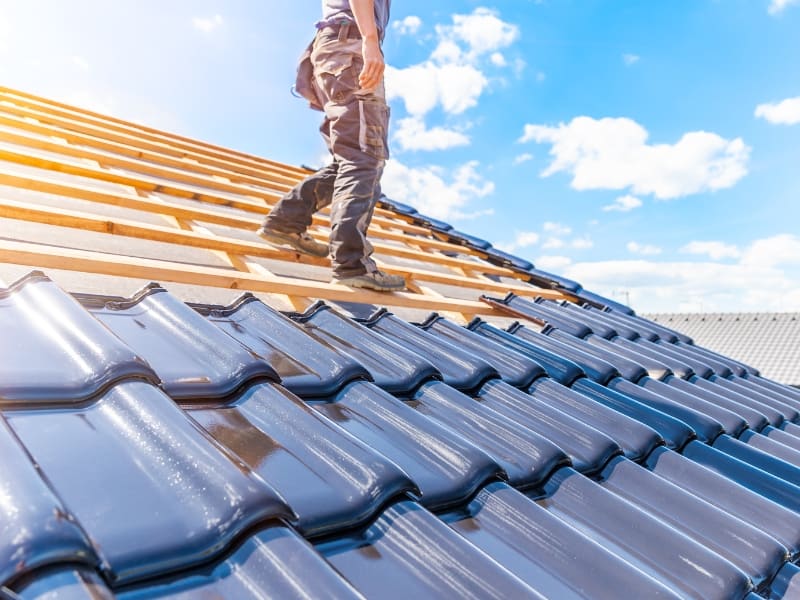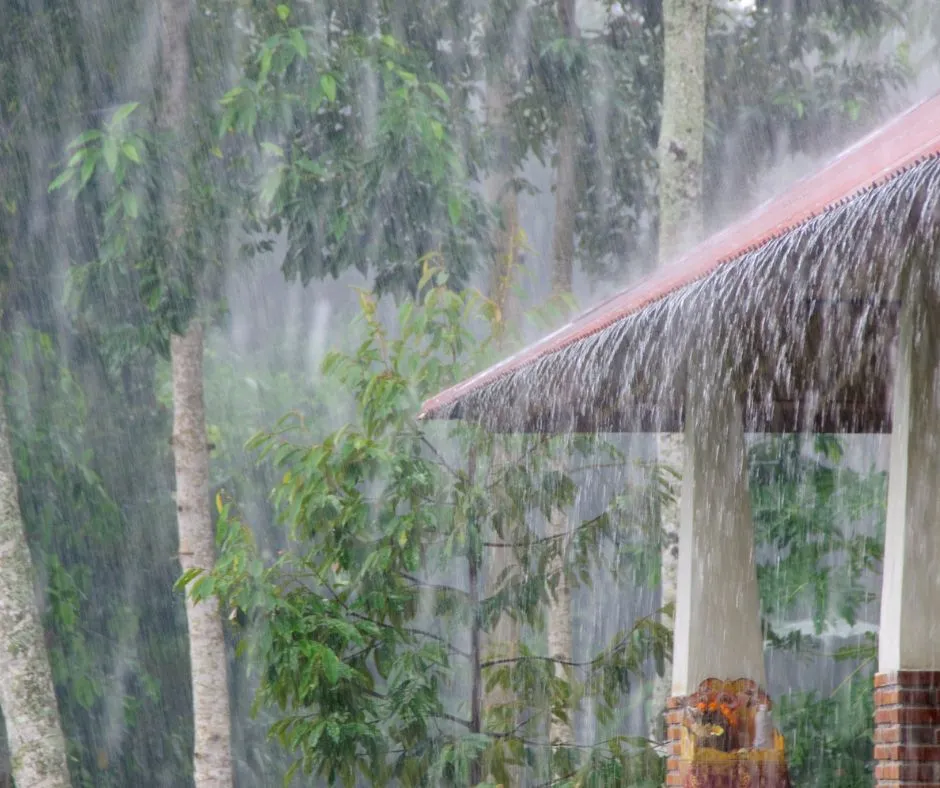-
Table of Contents
- How to Inspect Your Roof for Damage Before Heavy Rains
- What to Do If You Find Damage on Your Roof Before Heavy Rains
- Tips for Sealing Leaks and Cracks on Your Roof Before Heavy Rains
- How to Prepare Your Gutters and Downspouts for Heavy Rains
- What to Look for When Choosing a Roofing Material for Heavy Rains
- How to Protect Your Roof from Wind Damage During Heavy Rains
- Conclusion
 How to Inspect Your Roof for Damage Before Heavy Rains
How to Inspect Your Roof for Damage Before Heavy Rains
Heavy rains can cause severe damage to your roof if it is not in good condition. Inspecting your roof before heavy rains arrive to protect your home from water damage is crucial. Here are some tips to help you examine your roof for damage before heavy rains:
- Check for missing, cracked, or curled shingles. Missing, broken, or curled shingles can allow water to seep into your home, causing damage to your roof and interior. Look for any wear signs and replace damaged shingles as soon as possible.
- Look for signs of water damage. Water damage can include various things, such as missing or damaged shingles, clogged gutters, or damaged flashing. Look for any signs of water damage, such as discolored or stained areas on your roof or walls.
- Inspect your gutters and downspouts. Clogged gutters and downspouts can cause water to back up and damage your roof. Ensure your gutters and downspouts are clear of debris and securely attached to your roof.
- Check for damaged flashing. Flashing is the metal material used to seal the edges of your roof. If the flashing is damaged, water can seep into your home. Look for any signs of damage and replace any damaged flashing immediately.
Following these tips can help protect your home from water damage caused by heavy rains. Inspect your roof regularly and repair any damage as soon as possible.
What to Do If You Find Damage on Your Roof Before Heavy Rains
If you find damage on your roof before heavy rains, it is essential to take action quickly to prevent further damage. Here are some steps you can take to protect your roof and your home:
- Inspect the damage. Carefully inspect the area of the roof that is damaged. Look for any loose or missing shingles and any signs of water damage.
- Make temporary repairs. If you find any loose or missing shingles, use roofing cement to secure them, helping prevent further damage from the rain.
- Call a professional. If the damage is more extensive, it is best to call a professional roofer to repair it. They will assess the damage and make the necessary repairs to ensure your roof is secure.
- Check your gutters. Ensure your gutters are clear of debris and securely attached to your roof, preventing water from pooling on your roof and causing further damage.
- Check your attic. If you have an attic, check for any signs of water damage. If you find any water damage, repair as soon as possible to prevent further damage.
By taking these steps, you can help protect your roof and home from further damage caused by heavy rains.

Photo by Anna Atkins on Unsplash
Tips for Sealing Leaks and Cracks on Your Roof Before Heavy Rains
- Inspect Your Roof: Before attempting to seal any leaks or cracks on your roof, it is essential to inspect the entire roof for any signs of damage. Look for any missing, cracked, or lost shingles and any areas where water may be pooling.
- Clean the Area: Once you have identified the areas that need sealing, clean the area thoroughly. Use a brush and a mild detergent to remove any dirt, debris, or moss that may be present.
- Apply Caulk: Once the area is clean, you can apply a high-quality caulk to seal the cracks and leaks. Use caulk specifically designed for roofing applications.
- Apply Roofing Tape: You may need to use roofing tape for larger cracks and leaks. This tape is designed to provide a waterproof seal and can be applied directly over the crack or leak.
- Check for Leaks: After you have sealed the cracks and leaks, it is essential to check for any remaining leaks. You may need to apply additional caulk or roofing tape if you find any.
- Inspect Regularly: Ensure your roof remains in good condition through regular inspections to identify potential problems before they become serious.
By following these tips, you can help ensure that your roof is in good condition before the heavy rains arrive. Taking the time to inspect and seal any cracks or leaks can help prevent costly repairs in the future.
How to Prepare Your Gutters and Downspouts for Heavy Rains
Inadequately prepared gutters and downspouts can cause severe damage to your home during heavy rains. It is vital to take the necessary steps to prepare your gutters and downspouts for heavy rains ensuring your home’s protection from the elements.
First, inspect your gutters and downspouts for any signs of damage or clogs. If you find any clogs, use a garden hose to flush them out. If you notice any damage, such as holes or cracks, repair them immediately.
Next, ensure your gutters and downspouts are securely attached to your home. If they are loose or sagging, use a ladder to adjust them so they are correctly aligned.
Finally, check the downspouts to direct water away from your home. If the downspouts are not directing water away from your home, you may need to install extensions or splash blocks to run water away from your foundation.
By preparing your gutters and downspouts for heavy rains, you can help protect your home from water damage. If you have any questions or concerns, contact a professional for assistance.
What to Look for When Choosing a Roofing Material for Heavy Rains
When choosing a roofing material for heavy rains, several factors and considerations include looking for a waterproof material that can withstand the elements. Metal roofing is an excellent option, as it is highly durable and can withstand heavy rains and winds. Additionally, metal roofing is fire-resistant and can help protect your home from potential fires.
Another factor to consider is the slope of the roof. A steeply sloped roof is ideal for heavy rains, as it will help to shed water quickly and reduce the risk of water pooling on the roof. Additionally, a steeply sloped roof will help to reduce the risk of ice dams forming in the winter.
Finally, you should look for a roofing material that is easy to maintain. Metal roofing is an excellent option, requiring minimal maintenance, and can last for decades with proper care. Additionally, metal roofing is available in various colors and styles, so you can choose a roof that complements the look of your home.
By taking the time to consider these factors, you can ensure that you choose the best roofing material for your home and the heavy rains in your area.

How to Protect Your Roof from Wind Damage During Heavy Rains
Heavy rains can cause significant damage to your roof if you don’t take the necessary precautions. Wind can be especially damaging during heavy rains, as it can cause shingles to be torn off or even cause structural damage. Here are some tips to help protect your roof from wind damage during heavy rains:
- Inspect your roof regularly. Make sure to check for any loose or missing shingles and any signs of wear and tear. If you notice any damage, have it repaired quickly.
- Trim any trees near your roof, reducing the risk of branches falling on your roof during heavy winds.
- Install hurricane straps. These straps secure your roof to the walls of your home, which can help reduce the risk of wind damage.
- Install a ridge vent. This vent helps to reduce the pressure on your roof during high winds, which can help prevent shingles from being torn off.
- Install a wind turbine. This turbine will help to reduce the wind speed near your roof, which can help reduce the risk of damage.
Following these tips can help protect your roof from wind damage during heavy rains. Remember to inspect your roof regularly and take the necessary steps to repair any damage you find. Additionally, installing hurricane straps, a ridge vent, and a wind turbine can all help reduce the risk of wind damage.
Conclusion
Preparing your roof for heavy rains in Florida is crucial to protecting your home from water damage. By taking the time to inspect your roof, clean out your gutters, and make any necessary repairs, you can help ensure that your roof is ready to handle the heavy rains that come with Florida’s wet season. These steps can help you avoid costly repairs and keep your home safe and dry.








